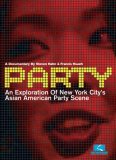| Reviews & Columns |
|
Reviews DVD TV on DVD Blu-ray 4K UHD International DVDs In Theaters Reviews by Studio Video Games Features Collector Series DVDs Easter Egg Database Interviews DVD Talk Radio Feature Articles Columns Anime Talk DVD Savant Horror DVDs The M.O.D. Squad Art House HD Talk Silent DVD
|
DVD Talk Forum |
|
|
| Resources |
|
DVD Price Search Customer Service #'s RCE Info Links |
|
Columns
|
|
|
Party
Text interspersed throughout the film makes sense of the riot of pounding hip-hop music, bustling bars, and throngs of noisy partygoers negotiating long lines. As the film points out, in New York Chinese go to "Asian" parties, while Koreans go to "Korean" parties, the latter being the film's primary focus. Caucasians and blacks aren't welcome at these events (a few non-Asians do turn up manning security or as musical guests, however) though the film isn't clear whether this policy is merely implicit or actively enforced.
Event promoters with names like SwerveNYC, BaseNYC, and MK Productions (named after the Korean taxi company?) have each staked out territory, with some upstarts promoting "mixed parties," which apparently cater to mostly Korean night-clubbers but allow other non-Korean Asians (and perhaps some white partygoers) to attend. Such events are held in large mainstream venues and draw upwards of 800-1,000 people, while promoters boast of raking in $50,000 in a single night just from the bar.
What draws so many 20-somethings to these massive events? Partygoers talk ("like, you know,") about these events as "meat markets," but add that Asian-American men and newly arrived immigrants ("FOBs," or "fresh off the boats") feel more comfortable approaching women in an environment where they're on an equal footing, that these events provide a "safe place" where everyone else is just like them. To some extent they fulfill the cultural expectations (or requirements) of their parents to date within one's culture, but Professor Okihiro sees other things at play. Whites in America, he argues, only have to function within their own "majority world," while most minorities have to straddle both the majority world (working regular jobs outside Koreatown, Chinatown, etc.) and their own inner subculture and its demands.
In the end, Okihiro argues, everyone in the world is essentially homeless -- that we create places that give us a sense of ownership (e.g., Korean parties, where only Koreans are allowed) but that this in turn only makes us less open to others, that in searching for our own identity (or as one critic says of these parties, where people "congregate like sheep") we simultaneously shut ourselves off from the rest of the world.
(As a white American living in a singularly homogenized Asian country, the last thing in the world I'd want to do is go to a big "whites-only" party. Indeed, every one of my expatriate friends and colleagues I've talked to about this is similarly disinclined toward such parties. If that's typical, why are such parties attractive to Asian minorities in America, but not white minorities living in Asia?)
This sense of ownership takes an unexpected turn near the end of the film when, following the catastrophic December 2004 Asian tsunami, a New York-based hip-hop radio station, Hot 97, aired an awesomely offensive "Tsunami Song" making fun of the tsunami's 300,000 victims. Hip-hop had long been the music of choice at Korean parties especially, and many felt betrayed by the industry they supported. That their sense of personal offense quickly becomes more important than their empathy for the tsunami victims seems to support the assertions of some interviewees who argue that young Asian-Americans are generally disinterested in anything beyond their immediate inner subculture.
Party is well-made with especially taut editing that maintains a high energy throughout its running time while effectively keeping spatial and inter-personal relationships clear at all times.
Video & Audio
Party is presented in 16:9 enhanced widescreen and looks fairly good for something shot on video. The stereo audio is reasonably strong. There are no subtitle options, though English subtitles do appear when the noise of the parties threatens to drown out the dialogue.
Extra Features
Supplements include a directors' audio commentary that this reviewer couldn't access through the special features menu. (If you select "on" the menu freezes up completely, though I was able to access it by selecting "play movie" and then pressing the audio button on my remote.)
Also included is a 12-minute directors' interview, a still gallery (partly made up of frame grabs) and a music-only soundtrack option.
Parting Thoughts
Party is a compelling little documentary that does what good documentaries are supposed to do: it raises a lot of questions and offers some possible answers, but gets audiences talking about its subject matter long after the movie has ended. Recommended.
Film historian Stuart Galbraith IV's most recent essays appear in Criterion's new three-disc Seven Samurai DVD and BCI Eclipse's The Quiet Duel.
|
| Popular Reviews |
| Sponsored Links |
|
|
| Sponsored Links |
|
|
| Release List | Reviews | Shop | Newsletter | Forum | DVD Giveaways | Blu-Ray | Advertise |
|
Copyright 2024 DVDTalk.com All Rights Reserved. Legal Info, Privacy Policy, Terms of Use,
Manage Preferences,
Your Privacy Choices | |||||||













